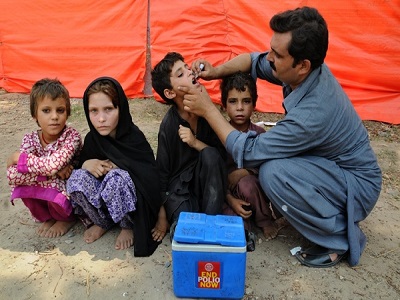Cover image: ©UNICEF/PAK/2014/ Waseem Niaz
Background
Under the guidance of the Global Polio Eradication Initiative (GPEI), the world is now on the brink of eradicating poliomyelitis. Polio Supplementary Immunization Activities (SIAs) are key interventions in achieving this goal.
As the lead agency in vaccine logistics and communication efforts in GPEI, UNICEF developed this e-learning course in order to provide programme managers with the most recent topics, guidance and tools on Cold Chain Logistics and Vaccine Management (CCL&VM) for polio SIA. This open-access interactive e-learning course is meant to complement the GPEI/UNICEF Guidance note on CCL&VM during polio SIA already available on the GPEI web page.
Course objectives:
At the end of this course, you will be able to:
- Understand and describe the basics of global polio eradication, polio vaccines and how the cold chain works.
- Plan and estimate vaccine needs for an SIA and calculate the packed volume of vaccines.
- Identify key cold chain equipment and estimate whether there is adequate cold chain equipment for an SIA.
- Describe best practices for vaccine handling, storage and distribution.
- Identify key aspects of vaccine quality and monitoring systems.
- Apply knowledge gained to solve SIA-related vaccine management and cold chain logistics problems at both the district and national levels.
Audience
Target group 1: GPEI (UNICEF, US CDC, Rotary, BMGF, WHO) mainly focusing on staff and consultants deployed to support Polio Eradication / SIA / OPS / Logistics (CCL&VM), functioning at national and/or sub-national levels.
Target group 2: Govt. Health programme managers responsible for immunization at national or subnational levels, especially those involved in polio SIAs.
Length
It should take you approximately 3 hours to complete all modules in this self-paced course.
Methodology
The course begins on a fictitious beach, where the learner receives a message in a bottle and is invited to go to a training centre to meet with a course host who will lead the learner through the module contents. The learner is also made aware that there are problems at the district and national level that will require assistance once the learner has completed some basic content. As the learner completes key module content, s/he is provided with “badges” summarizing key content needed to solve the problems. At the beginning of Modules 5 and 6, the learner once again receives a message in a bottle from a new pedagogical agent, summoning the learner to help solve problems in a hypothetical country at the district (Module 5) and national (Module 6) levels. The first four modules of the course are designed to provide the learner with decontextualized skills acquisition, focusing on basic information about each of the critical content areas needed to achieve the course learning goals. The fifth and sixth modules are designed to allow the learner to apply the knowledge gained through the badges within problem solving scenarios that take place before, during, and after an SIA at the district and national levels. An end-of-course assessment is also available to test knowledge of all modules. A certificate can be printed on successful completion of this test.
Structure
This course comprises 6 modules:
- Module 1- Overview: Polio eradication, vaccines and SIAs
- Lesson 1.1: Polio eradication & the GPEI
- Lesson 1.2: Vaccine characteristics and the cold chain
- Module 2 - The basics: Target & vaccine estimation
- Lesson 2.1: Planning & estimating vaccine needs for polio SIAs
- Lesson 2.2: Estimating packed volume
- Module 3 - The basics: Cold chain equipment & vaccine handling
- Lesson 3.1: Cold chain equipment
- Lesson 3.2: Supply, storage & distribution of vaccines
- Lesson 3.3: Day-to-day vaccine handling and reporting
- Module 4 - The basics: Quality and monitoring
- Lesson 4.1: Vaccine quality issues
- Lesson 4.2: Monitoring & supervision
- Module 5 - Take charge: District level (Problem solving activity)
- Module 6 - Take charge: National level (Problem solving activity)
- Final Course Evaluation (Certificate available on successful completion.)
Contact details:
Anindya Bose - abose@unicef.org / Ahmet Afsar - aafsar@unicef.org
